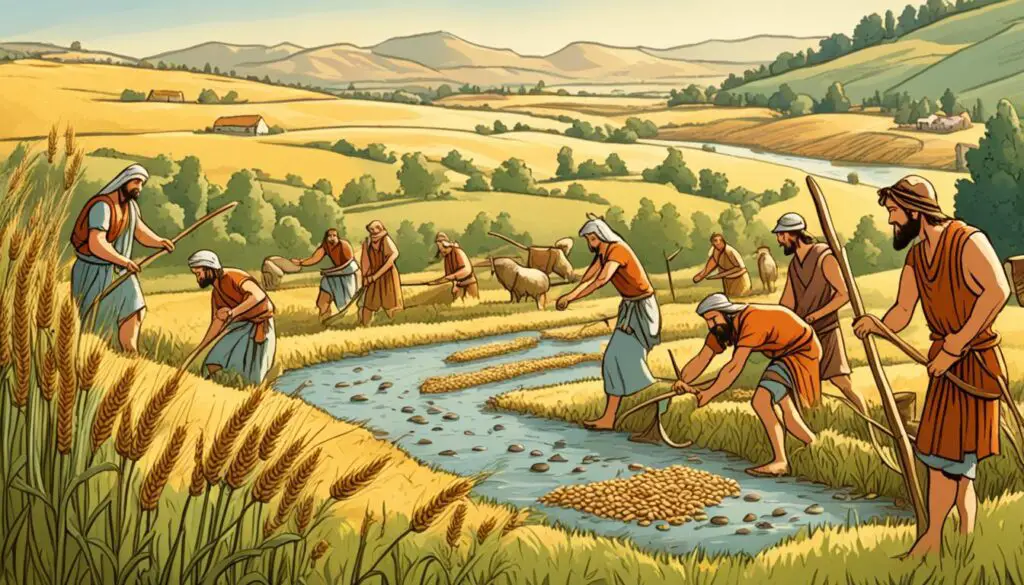The Neolithic Age, also known as the New Stone Age, was a significant period in human history. It marked the transition from a hunter-gatherer lifestyle to one of settled agriculture and the development of complex societies. The Neolithic Revolution, as it is often called, brought about major changes in the way humans lived and interacted with the environment.
The invention of agriculture, domestication of animals, and the establishment of permanent settlements are some of the key developments that occurred during the Neolithic Age. This period, which began around 10,000 years ago, laid the foundation for the rise of ancient civilizations and the shaping of modern civilization as we know it today.
Key Takeaways:
- The Neolithic Age marked the transition from a hunter-gatherer lifestyle to settled agriculture.
- Key developments during this period include the invention of agriculture, domestication of animals, and the establishment of permanent settlements.
- The Neolithic Age laid the foundation for the rise of ancient civilizations.
- This period shaped modern civilization through advancements in agriculture and the development of complex societies.
- Agriculture remains a vital part of our society, influenced by the practices of the Neolithic Age.
The Neolithic Revolution: Shift to Agricultural Lifestyle
The Neolithic Revolution was a pivotal turning point in human history, marking the transition from a nomadic hunter-gatherer lifestyle to a settled agricultural existence. This revolution brought about significant changes in farming practices, the domestication of animals, and overall agricultural advancements.
The development of agriculture allowed early humans to cultivate crops such as wheat, barley, and rice. This shift from relying solely on foraging for food to actively growing crops ensured a more stable and sustainable food supply. With the ability to harvest crops, communities could now plan for future needs, paving the way for settled life.

The domestication of animals played a crucial role in the Neolithic Revolution. Humans discovered that they could tame and breed animals like goats, sheep, and cows for various purposes. Domesticated animals provided a constant supply of food through their milk, meat, and eggs. They also became valuable assets for labor, assisting in tasks such as plowing fields and transporting goods. This symbiotic relationship between humans and animals contributed to the success and efficiency of agricultural practices.
The Neolithic Revolution brought about significant advancements in agriculture, enabling humans to thrive and develop permanent settlements. With settled life, communities could establish complex social structures and governance systems. Specialization emerged, with individuals focusing on specific trades and crafts. This division of labor not only fostered economic growth but also led to the development of technologies and innovations aimed at improving farming practices.
The impact of the Neolithic Revolution cannot be overstated. This monumental shift to an agricultural lifestyle laid the foundation for the rise of civilizations, the development of advanced societies, and the eventual shaping of modern civilization as we know it today.
Impact of the Neolithic Age: From Ancient Civilizations to Modern Society
The Neolithic Age has had a profound and enduring impact on our world, shaping the course of human history. This crucial period witnessed the rise of influential ancient civilizations in regions like Mesopotamia, Egypt, and the Indus Valley. These civilizations laid the foundations for the development of complex societies, introducing writing systems, legal codes, and architectural marvels that continue to inspire us today.
The Neolithic Age brought about a significant shift in human lifestyle through advancements in agriculture and animal domestication. The ability to cultivate crops and tame animals revolutionized our approach to food production, leading to increased yields and surplus. This surplus, in turn, allowed communities to grow and sustain larger populations, creating the conditions for specialization of labor.
With surplus food at their disposal, people could dedicate their time to various trades and crafts, which led to an emergence of social hierarchies and the division of labor. This specialization contributed to the cultural evolution of ancient civilizations, enabling the development of sophisticated societal structures, religious practices, and technological advancements.
The Neolithic Age also marked the transition from hunter-gatherer societies to urban dwellers. The establishment of permanent settlements paved the way for the growth of cities, the expansion of trade networks, and the exchange of ideas across vast regions. The innovations and knowledge gained during this time continue to shape our modern civilization, with agriculture remaining a vital part of our society. The legacy of the Neolithic Age is evident in our advancements in farming practices, our complex social systems, and our continuous evolution as a species.
FAQ
What is the Neolithic Age?
The Neolithic Age, also known as the New Stone Age, was a significant period in human history. It marked the transition from a hunter-gatherer lifestyle to one of settled agriculture and the development of complex societies.
What is the Neolithic Revolution?
The Neolithic Revolution brought about a significant shift in human lifestyle. It was during this time that humans started to transition from a nomadic hunter-gatherer existence to a settled agricultural lifestyle. The development of agriculture allowed people to cultivate crops and ensured a more reliable food supply.
What were the key developments during the Neolithic Age?
Some key developments during the Neolithic Age include the invention of agriculture, domestication of animals, and the establishment of permanent settlements.
How did agriculture impact the Neolithic Age?
Agriculture revolutionized the way people lived during the Neolithic Age. It enabled the cultivation of crops and provided a reliable food supply. It also led to the establishment of permanent settlements and the development of complex social structures.
What is the legacy of the Neolithic Age?
The Neolithic Age laid the foundations for the rise of ancient civilizations and the shaping of modern civilization as we know it today. It led to advancements in agriculture, the emergence of cities, trade networks, and technological advancements.
How did the Neolithic Age impact modern society?
The impact of the Neolithic Age is far-reaching and continues to shape our world today. It witnessed the rise of ancient civilizations, the development of writing systems, legal codes, and the transformation of humans from hunter-gatherers to urban dwellers.
